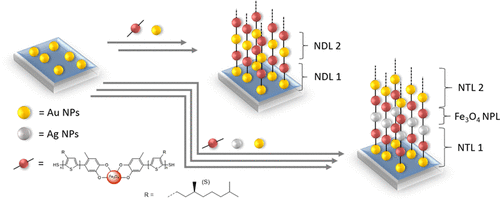当前位置:
X-MOL 学术
›
Macromolecules
›
论文详情
Our official English website, www.x-mol.net, welcomes your
feedback! (Note: you will need to create a separate account there.)
Development of a Layered Hybrid Nanocomposite Material Using α,ω-Bifunctionalized Polythiophenes
Macromolecules ( IF 5.1 ) Pub Date : 2020-11-30 , DOI: 10.1021/acs.macromol.0c01593 Jonas Delabie 1 , Julien De Winter 2 , Olivier Deschaume 3 , Carmen Bartic 3 , Pascal Gerbaux 2 , Thierry Verbiest 4 , Guy Koeckelberghs 1
Macromolecules ( IF 5.1 ) Pub Date : 2020-11-30 , DOI: 10.1021/acs.macromol.0c01593 Jonas Delabie 1 , Julien De Winter 2 , Olivier Deschaume 3 , Carmen Bartic 3 , Pascal Gerbaux 2 , Thierry Verbiest 4 , Guy Koeckelberghs 1
Affiliation

|
In this study, a new chiral α,ω-bifunctional polythiophene is synthesized and used as a nanoparticle linker molecule to synthesize the first layered conjugated polymer/nanoparticle (CP/NP) hybrid material to induce a potential nonreciprocal optical rotation. The bifunctionalized polythiophene (PT) is synthesized using a controlled Kumada catalyst-transfer condensation polymerization (KCTCP) mechanism utilizing a combination of a catechol-functionalized Ni-initiator and a termination process with S8 and 1,8-diazabicyclo[5.4.0]undec-7-ene (DBU), to quantitatively obtain a catechol and thiol end-capped poly(3-((S)-3,7-dimethyloctyl)thiophene). The catechol group has a high affinity for magnetite NPs, while the thiol end group prefers to bind with metallic NPs such as silver and gold. Using these properties, both a double-layered material, consisting of repeated layers of gold and magnetite NPs, and a triple layered material, consisting of gold, magnetite, and silver NPs was made, where each NP layer was linked with the previously synthesized polymer. This was achieved by first functionalizing magnetite NPs with the polymer, resulting in free thiol ends on these hybrid magnetite NPs. Using these hybrid magnetite NPs allowed for a selective layered construction by alternating a metallic layer with these hybrid magnetite NP layers. In this way, a system with up to eight double layers and a system with three triple layers was synthesized and analyzed using UV–vis and atomic force microscopy (AFM) measurements. Finally, also the nonreciprocal properties were tested.
中文翻译:

使用α,ω-双官能化聚噻吩开发多层杂化纳米复合材料
在这项研究中,合成了一种新的手性α,ω-双官能聚噻吩,并用作纳米粒子接头分子来合成第一个层状共轭聚合物/纳米粒子(CP / NP)杂化材料,以引起潜在的不可逆旋光。双官能化聚噻吩(PT)是通过受控的Kumada催化剂转移缩聚(KCTCP)机制合成的,该机制结合了邻苯二酚官能化的Ni引发剂和具有S 8和1,8-二氮杂双环的终止过程[5.4.0] undec-7-ene(DBU),以定量获得邻苯二酚和巯基封端的聚(3-((S)-3,7-二甲基辛基)噻吩)。邻苯二酚基对磁铁矿NP具有很高的亲和力,而巯基端基则倾向于与金属NP(如银和金)结合。利用这些特性,可以制成由重复的金和磁铁矿NP组成的双层材料,以及由金,磁铁矿和银NP组成的三层材料,其中每个NP层均与先前合成的聚合物连接。这是通过首先用聚合物官能化磁铁矿NP来实现的,从而在这些杂化磁铁矿NP上产生了游离的硫醇末端。使用这些混合磁铁矿NP可以通过将金属层与这些混合磁铁矿NP层交替来进行选择性的层状构造。通过这种方式,合成并使用紫外可见光谱和原子力显微镜(AFM)测量分析了最多包含八个双层的系统和包含三个双层的系统。最后,还测试了不可逆特性。
更新日期:2020-12-22
中文翻译:

使用α,ω-双官能化聚噻吩开发多层杂化纳米复合材料
在这项研究中,合成了一种新的手性α,ω-双官能聚噻吩,并用作纳米粒子接头分子来合成第一个层状共轭聚合物/纳米粒子(CP / NP)杂化材料,以引起潜在的不可逆旋光。双官能化聚噻吩(PT)是通过受控的Kumada催化剂转移缩聚(KCTCP)机制合成的,该机制结合了邻苯二酚官能化的Ni引发剂和具有S 8和1,8-二氮杂双环的终止过程[5.4.0] undec-7-ene(DBU),以定量获得邻苯二酚和巯基封端的聚(3-((S)-3,7-二甲基辛基)噻吩)。邻苯二酚基对磁铁矿NP具有很高的亲和力,而巯基端基则倾向于与金属NP(如银和金)结合。利用这些特性,可以制成由重复的金和磁铁矿NP组成的双层材料,以及由金,磁铁矿和银NP组成的三层材料,其中每个NP层均与先前合成的聚合物连接。这是通过首先用聚合物官能化磁铁矿NP来实现的,从而在这些杂化磁铁矿NP上产生了游离的硫醇末端。使用这些混合磁铁矿NP可以通过将金属层与这些混合磁铁矿NP层交替来进行选择性的层状构造。通过这种方式,合成并使用紫外可见光谱和原子力显微镜(AFM)测量分析了最多包含八个双层的系统和包含三个双层的系统。最后,还测试了不可逆特性。











































 京公网安备 11010802027423号
京公网安备 11010802027423号